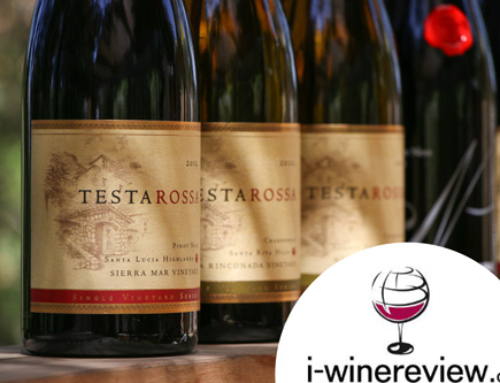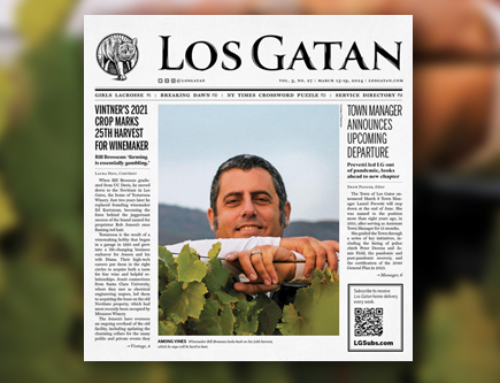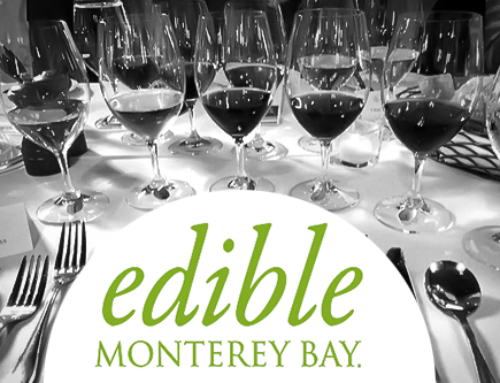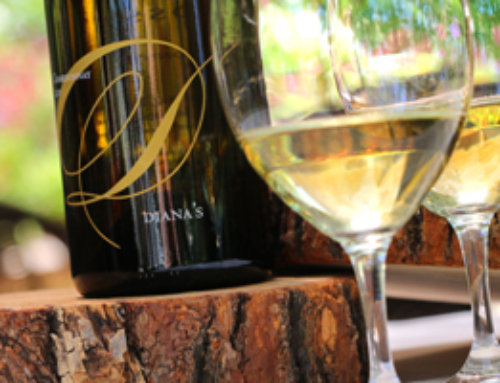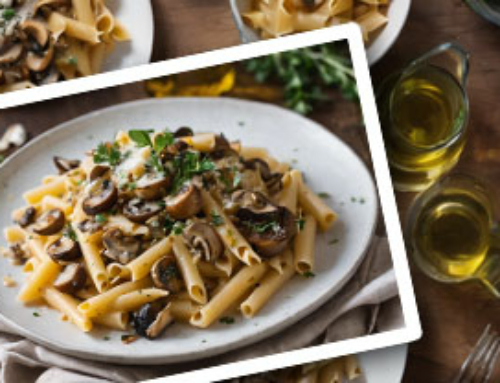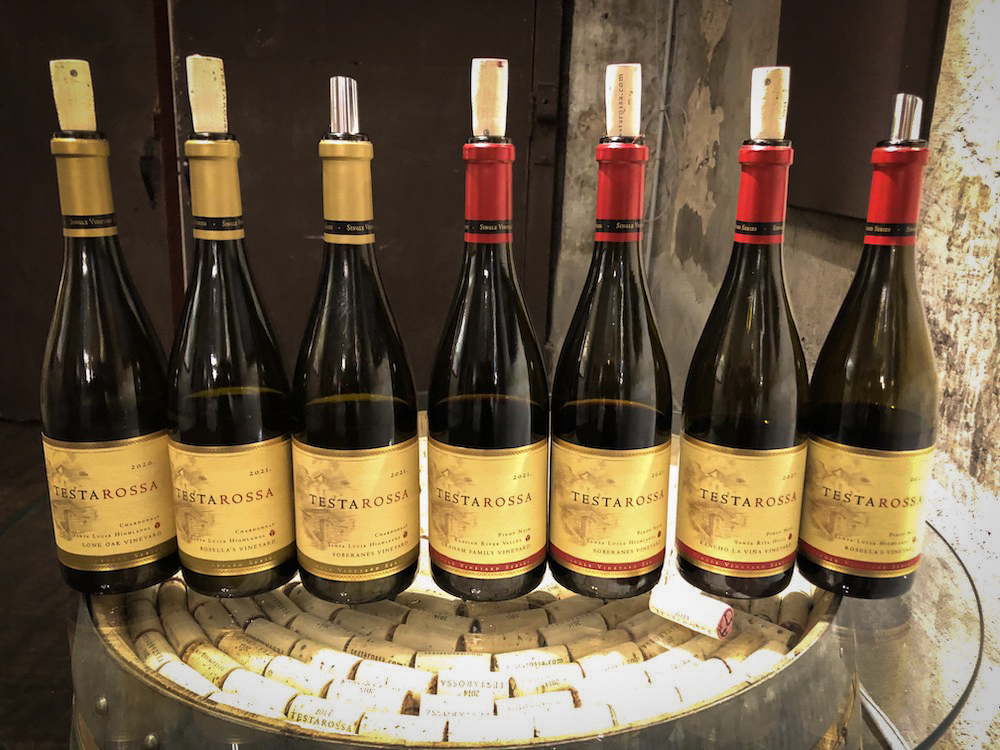
Testarossa’s current lineup of wines (Photo: Laura Ness)
March 10, 2023 – Dialing in just the right barrel program for a vineyard, especially for Pinot Noir and Chardonnay, takes time, money and patience. When wineries first start out, they often buy all new barrels, and it can take several vintages to achieve that perfect mix of cooperages, and that winning formula of new, once used, twice used, and so forth.
When I tasted through a current lineup of vineyard designate wines with longtime winemaker Bill Brosseau, lead wine educator Sue Ryan and newly hired marketing manager Irena Gumbert, there was not a shred of overt oakiness to be found. No flash of burnt toast or heaviness.
“You might see that the percentage of new oak in our wines has actually gone up over time, but that doesn’t tell the actual story,” explains Brosseau. “I’ve been experimenting with so many coopers, forests, toast methods and toast levels over the years. I think we have finally arrived at the optimal combination of toast levels and length of time in barrel. We’ve also learned so much about each vineyard and the type of barrel that works best with that particular fruit.”
With so many vineyards to work with, and the constant tweaking of these sources, instituting better farming practices and in some cases, dropping vineyards altogether, there has been a good deal of trial and error over the last two plus decades. Brosseau says finding the right oak fit for each site is like Dancing with the Stars.
“We now are working with 15 coopers and 60 unique barrel types. We’ve gone from barrels that are 20 to 3 year air-dried, to 4-year air dried, with less overall toast. Most reds are now getting 50 to 60% new wood, but for shorter time periods. We are putting less new oak on our whites: we leave them in oak just to the point of noticing it,” he says.
In the past, they might have used 40 to 45% new, but it was far more overt and powerful. Now, the barrels they employ have significant impact in years 2 and 3, whereas the previous barrels were one and done. The things you discover when you make a lot of different wines every year, always searching for the perfect voice of a place, instead of a formulaic expression.
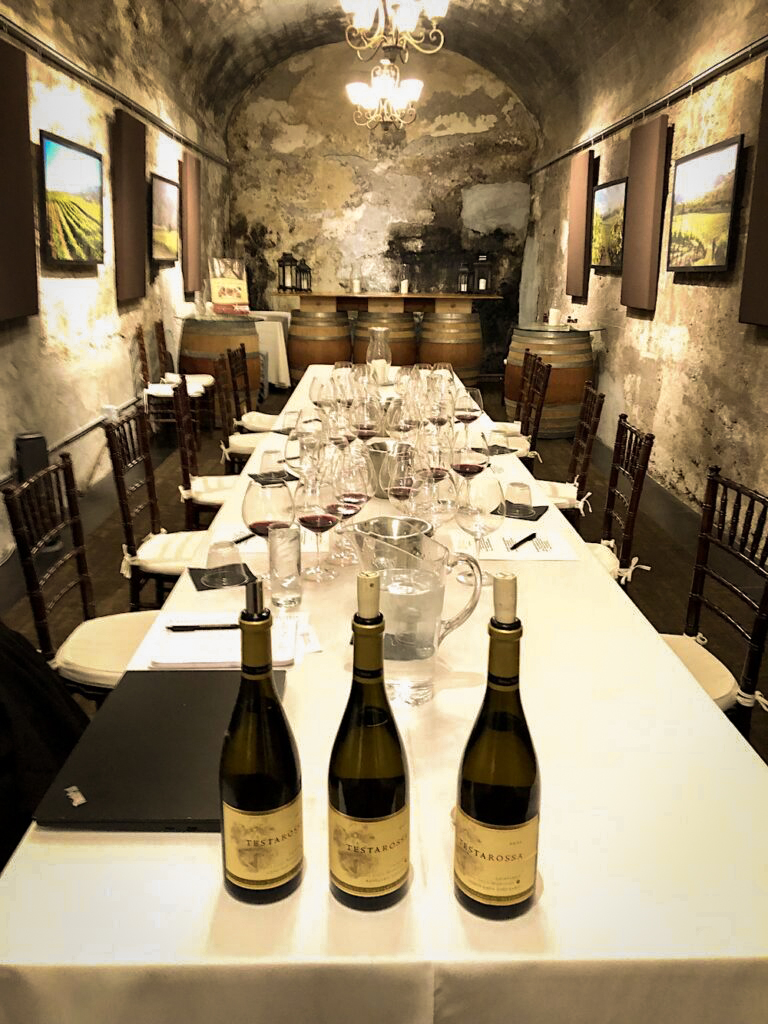
Cellar 1 at Testarossa in Los Gatos (Photo: Laura Ness)
As we tasted the 2021 Graham Family Vineyard Russian River Pinot Noir, for example, proprietor Rob Jensen reminded us that at one point, they had vineyard sources from Santa Barbara all the way to the Russian River, and several in between. “It was too much for one person, aka, Bill, to manage all those vineyards. He would have spent his whole life in the truck!”
Which honestly, Bill does anyway, once fruit starts to ripen, as he is one of those diehard “Wine is Made in the Vineyard” guys. One of the things that gets him most excited is tasting the fruit in a really good vineyard. “It’s like being a kid in Willy Wonka’s Chocolate Factory!”
Jensen shared that he absolutely hated to tell Ana Keller of Keller Estate in Sonoma (now Petaluma Gap AVA) that they could no longer take her La Cruz Vineyard fruit, as they had decided to focus on fruit mainly from Monterey and San Benito counties.
Back in 1997, before Brosseau even came on board, they made their first vintage from Pisoni Vineyard, which put Testarossa squarely on the map with a head-turning Pinot Noir that got critic’s attention and made them very welcome in the Santa Lucia Highlands.
Not long after that, in 1999, they began making Pinot Noir from Garys’ Vineyard, and Chardonnay from Rosella’s. In 2001, they began making Pisoni clone Pinot Noir from Rosella’s, followed by Pinot Noir from Doctor’s in 2008 and Chardonnay from Lone Oak in 2010. Both are SLH vineyards owned and farmed by the Hahn Family, one of the early pioneers in the region.
Brosseau Vineyard, planted in 1980 is owned by Bill’s family and he has helped farm it since he was old enough to pick and prune. It became part of the Testarossa portfolio in 2002, and they’ve been making both Chardonnay (Wente clone, planted in 1980), and Pinot Noir (113, 114, 115, Mt. Eden, Pommard 4, planted in 1980), from it ever since. It’s often the first vineyard in at harvest time.
In 2010, a collaboration with the owners of another Santa Lucia Highlands vineyard, Fogstone Vineyard (Bret and Carol Sisney and Gary Filzetti), led to it becoming a Testarossa staple for both Chardonnay and Pinot Noir.
One of the most exciting of the SLH vineyards in terms of complexity has proven to be the Soberanes Vineyard, farmed by the Pisoni and Franscioni families and planted to Chardonnay and Pinot Noir in 2008. Testarossa has been making a vineyard designate of each since 2011.
Another longtime staple of the SLH portfolio, Tondre Grapefield, was added in 2012 for Pinot Noir and for Chardonnay in 2014. Sierra Mar, owned by the Franscioni family and planted in 2007, became part of the Testarossa story in 2017, with Chardonnay, and with Pinot Noir in 2018.
They began to branch out of the SLH with Sanford & Benedict Vineyard in the Santa Rita Hills, with both Chardonnay (Wente and clone 4, planted in 1971) and Pinot Noir in 2004. It was replanted in 2008—2010 to Calera, 115, 2A and Archery Summit clones of Pinot Noir. The vineyard is owned by the Terlato Family.
It was by way of the Terlato connection that Brosseau began getting fruit from La Rinconada Vineyard, also in the Santa Rita Hills, in 2012 (Chardonnay) and in 2013, Pinot Noir. This relationship led to discovering Rancho La Vina, a Santa Rita Hills AVA vineyard, owned by the Baer Family, in 2020, a godsend when SLH fruit was mostly a loss due to the fires. The vineyard was planted in 2006. It’s such a great addition to the lineup.
Which brings us back to the wines we tasted. There were three excellent Chardonnays: 2020 Lone Oak, 2021 Rosella’s and 2021 Soberanes, all from the Santa Lucia Highlands. The Lone Oak, planted originally in 1970 and then interplanted in1997, shows aromas of hyacinth, tangerine and lime, with flavors of white fig and hazelnut, and a finish of shortbread cookie. It’s a low-yielding site due to its age, with only 5 to 7 clusters per vine! Think about that.
We loved the 2021 Rosella’s for its endearing perfume and lemon curd aromas and sumptuous yet delicate flavors of peach cobbler that do not want to quit. Such a pretty wine! As a group, we were over the moon about the Soberanes, which leads with white chocolate lemon biscotti and a hint of coconut, and deep dives into lush, tangy and tantalizing lemon cream pie. Both the structure and acidity are incredibly rewarding in this wine. Brosseau admits this vineyard took a bit of dialing in. “It was such a hard one to mail at first. There were many different clones in the block I started with, and they had different ripening schedules, so dialing in those picks was crucial.” The result of isolating the clones that work best paid off, as this is a wine with amazing fortitude.
Next up was the lineup of four Pinot Noirs, beginning with the 2021 Graham Family,
They started working with Howard Graham, who lives in Monte Sereno and has been a longtime Testarossa supporter, in 2004, and have kept coming back year after year, as it’s a fan favorite, for its sweet cherry pie and cola flavors. “Much of Russian River Pinot Noir needs oaj tannin because the fruit does not have a lot of that naturally,” says Brosseau. That’s why he used 71% new French oak.
The 2021 Rosella’s Vineyard Pinot Noir was a darling, with the nose of sweet red licorice and rose petals and its failsafe silky texture that lingers long and lovely on the palate. This is Sunday afternoon Pinot Noir with chamber music in a rose garden.
The 2021 Soberanes Vineyard Pinot Noir is done in Tonnellerie de Mercurey LF (light and fruity) barrels that add a magical texture to this powerful wine that opens with rosehips tea, orange peel and lanolin, and then glides wonderfully across the palate like a schooner into the sunset. There’s a wonderfully savory note of tomato basil that keeps it more than interesting. This was a group favorite to which we kept returning, because of its seemingly eternal dimensions.
The group seemed to be doing even more cartwheels over the 2021 Rancho La Viña Vineyard Pinot Noir, with its instantly engaging and powerful aromatics of dark raspberry, currant, tomato leaf, fir and endless spice. The savory notes in this wine are riveting, and I daresay this will be the one that ends up being the Cellar Queen.
Were it not for the devastating fires of 2020, Brosseau might not ever had the chance to taste the fruit from this vineyard. And we would not have the opportunity to enjoy and revel in this amazingly complex and curiosity stirring wine.

